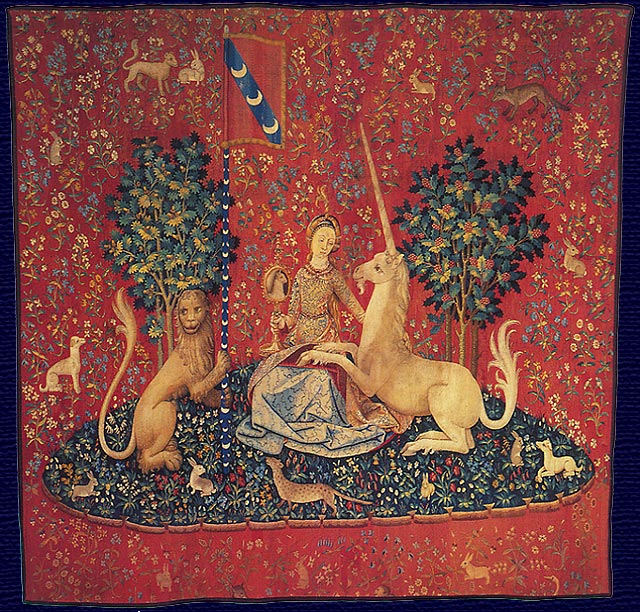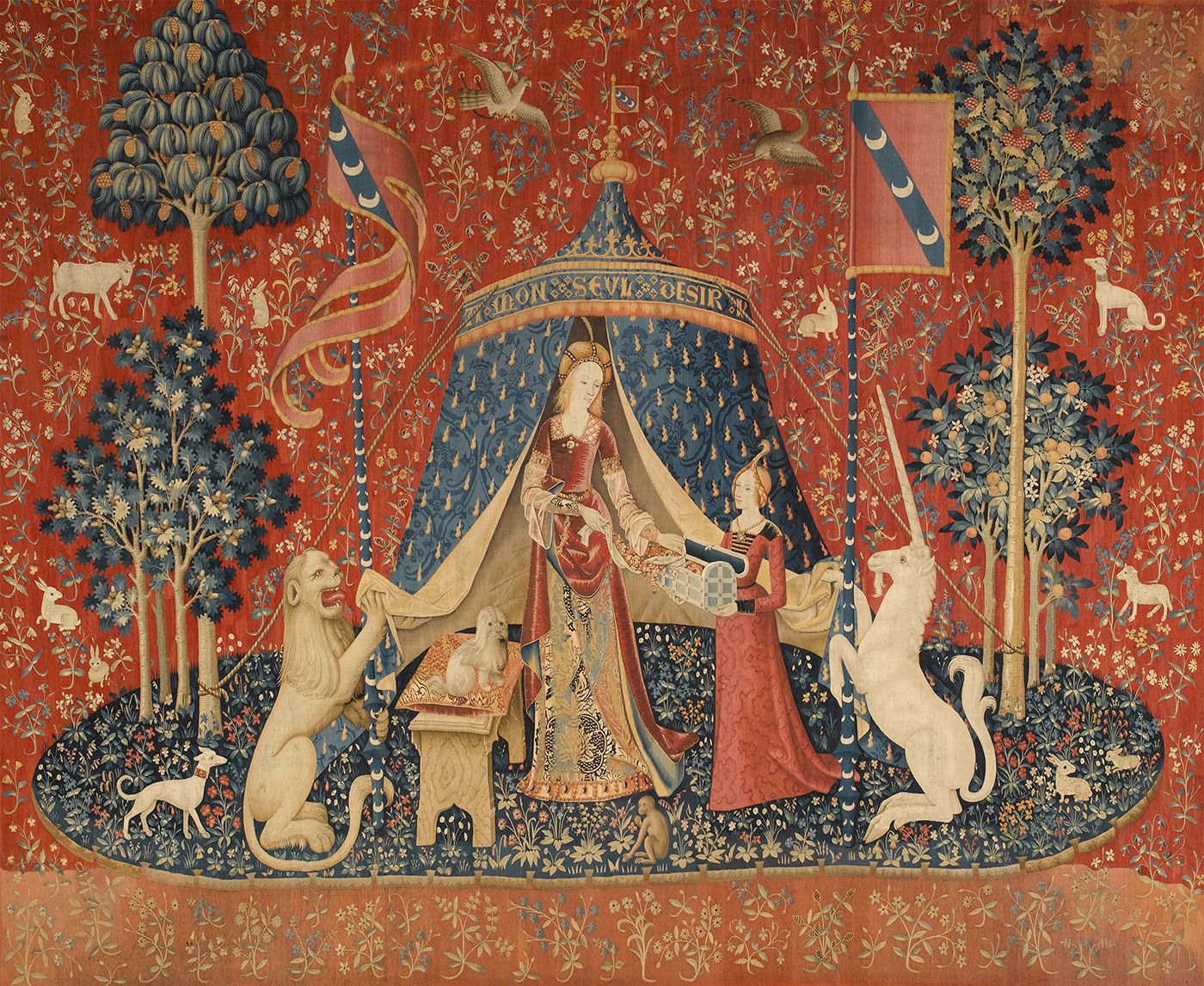
This article was first published 28th May, 2020 on #FolkloreThursday.com titled, Unicorn Lore: Interpreting the Lady and the Unicorn Tapestries, by zteve t evans and has been revised, edited and exra images added 13 Feb 2024.
The Elusive Unicorn
The rare, elusive, mythical, magical unicorn has been part of world folklore and legend for centuries, evolving spectacularly into the modern age. Unicorn-themed products, including toys and art pieces, are widely available in the market and featured in various media forms such as literature, films, and television. During the medieval and Renaissance eras, the unicorn was a popular subject in works of art, tapestries, and coats-of-arms of the wealthy and powerful, influencing the modern perception of the mythical creature. Below is an overview and brief discussion of six late medieval tapestries called “The Lady and the Unicorn” or “La Dame à la licorne.” Today, these designs are replicated in various places, notably adorning the walls of Gryffindor Common Room in the Harry Potter movies.
The Lady and the Unicorn
These tapestries were believed to have been created around 1500 but became lost and rediscovered in the 19th century in the Château de Boussac, Creuse, France. In 1882, they were moved to Paris to the Musée de Cluny, which became the Musée National du Moyen Âge. In length, the tapestries total twenty metres, requiring great skill, patience, and time to create. The best available materials were used and would have been massively expensive to produce. Only a select few of society’s wealthiest and most influential members could have commissioned such a costly work in those days.
Interpreting the Lady and the Unicorn Tapestries
Why the tapestries were first commissioned, and their original meaning and purpose remains a mystery lost through the ages but argued about today. Medieval people would have understood what each of the figures, motifs and symbols in each scene meant and how they were all part of an extended allegory that came together to create an overall meaning or message. Today, multiple theories exist regarding the interpretation of these pieces of art. However, the most widely accepted theory among art historians is that the six tapestries are allegorical works symbolizing the five human senses of sight, hearing, taste, touch, and smell. In this theory, the sixth and centre piece of the set represents a sixth sense. The six scenes depict a medieval realm where myth and folklore interact with the natural and human worlds, mixed with Christian spirituality and morality. In each scene, the lady and the unicorn take a significant role, supported by a lion and a monkey, with many other depictions of fauna and flora in the background. The unicorn and the lion usually appear holding a standard that frames the lady, except in the tapestry representing sight.
Sight

This tapestry depicts the unicorn laying its forelegs in the lady’s lap. In medieval myth and legend, unicorns were the fiercest and swiftest creatures and could only be captured and tamed by a virgin sitting in the woods patiently waiting for one to approach and tamely lay its head in her lap in surrender. This scene shows a unicorn being tamed by the virgin or mollified earlier by her. The lady holds a golden mirror, and the unicorn appears to gaze at its reflection. However, the mirror is positioned to show the aspect of the unicorn that the lady sees of the animal. This scene depicts that it has given up its standard bearer role, leaving the lion to bear a single standard.
Hearing

The lady appears with a female companion in this tapestry. The sense of hearing is represented by a musical instrument, known as a positive or pipe organ, played by the lady. The unicorn and the lion frame the scene and appear captivated by the sound. Smaller images of the unicorn and lion appear on the upright posts of the instrument. The lady plays the instrument while her smaller companion squeezes the bellows behind that pump the air through the pipes, creating the musical sounds. Musical ability was a highly regarded skill, and being an accomplished musician was considered noble, courtly, and an attribute of high personal refinement.
Taste

In this tapestry, the lady is feeding a delicacy to her parrot. There is also a monkey present, which also appears to be eating. During these times, it was not unusual to see monkeys in images as they represented the lower or shameful instincts humans needed to keep under control. Other animals present are a lion cub and an immature unicorn that has yet to grow a horn. The scenes are set in an enclosed garden, often where courtly love occurs. In Christian symbolism, it was a place of purity and was believed to symbolize impenetrability and the virginity of the Virgin Mary. On the lady’s belt is a pomegranate, a symbol of fertility and associated with the hunting of the unicorn.
Touch

In the tapestry representing touch, the lady is alone in the garden with her animals or pets. She is holding a banner in one hand, which invokes the sense of touch. In the other, she grasps the upright horn of the unicorn, suggesting the unicorn is a substitute for her lover.
One interpretation of this scene is that she captured and tamed the unicorn’s heart. In the background, the monkey, cheetah, leopard, and other animals are wearing collars, reinforcing the idea of their capture and mastery by her and possibly indicating she has tamed her lower animal instincts. The lady wears a tiara over her loose hair; in medieval allegory, loose-flowing hair suggests virginity. She is wearing a dark blue velvet dress lined with ermine, another symbol of purity. Wide ornamental bands adorned with gold and precious gems edge the dress.
Smell

This tapestry presenting the allegory of the sense of smell shows the lady making a garland of fragrant carnations. The allegory is reinforced by a monkey smelling a rose. The garland of flowers was often used as a motif in the symbolism of love, and lonely lovers were frequently shown in garden settings weaving flower garlands. The carnation was symbolic of profane and sacred love and was fashionable then. Another fashion was how the lady wore her bracelets at the wrist instead of higher up the arm. In all the tapestries, the heraldic symbols on display are those of the Le Viste family, but in this tapestry, the coat of arms worn by the lion is running the wrong way.
6th Sense, or “À mon seul désir”

The sixth tapestry is known as the Sixth Sense or “À mon seul désir” in French and “My Sole Desire” in English because these words are written in a mysterious message depicted around the top of the blue pavilion. This enigmatic phrase is seen as the key to its interpretation. The scene depicted on the tapestry can be interpreted in several ways. It could represent a sixth sense if interpreted as an extended allegory of the senses like the other tapestries. The sixth sense in medieval times referred to the heart, mind, and soul as one sense which was not only the source of morality but also that of carnal desire. Although it could refer to a more romantic interpretation, it can also be interpreted as moral reasoning or free will. Here, the lady appears to be placing jewels in a casket, but paradoxically, she could be taking them out. There is a question as to whether she is accepting the jewels and, in doing so, accepting the pleasures of the senses, or rejecting them and the earthly treasures they represent. Whichever she is doing, she is doing so by her own free will or sole desire. Another theory is that if the mystery phrase is translated as “my unique desire,” the idea arises that only humans covet material objects such as jewelry, making us exceptional among life on Earth because no other creature does this. Yet, because of our unique desires, we are not entirely in the natural world around us or the mythical world we create.
Myth and Nature
The six scenes depict the lady accompanied by various animals amid numerous plants in a world where myth and nature are interwoven to create an overall statement. We may never know these stunning tapestries’ original message and purpose, but their mystery and beauty remain.
© zteve t evans
References, Attributions and Further Reading
Copyright zteve t evans
- The Lady with the Unicorn | Musée de Cluny (musee-moyenage.fr)
- The Lady and the Unicorn – Wikipedia
- The Lady and the Unicorn Tapestries – Windlesham Lyceum
- The Symbolism of ‘The Lady and the Unicorn’ Tapestry Cycle
- Unicorn – Wikipedia
- Tapisseries, tissus et broderies (archive.org)
- Explainer: the symbolism of The Lady and the Unicorn tapestry cycle (theconversation.com)
- The Lady and the Unicorn – The symbolism and meaning of the tapestries by Yuki Fukazawa.
- Images
- Sight – File:The Lady and the unicorn Sight.jpg – Wikimedia Commons
- Hearing – File:(Toulouse) L’Ouïe (La Dame à la licorne) – Musée de Cluny Paris.jpg – Wikimedia Commons – Public Domain
- Taste – File:(Toulouse) Le Goût (La Dame à la licorne) – Musée de Cluny Paris.jpg – Wikimedia Commons – Public Domain
- Touch – File:(Toulouse) Le toucher (La Dame à la licorne) – Musée de Cluny Paris.jpg – Wikimedia Commons – Public Domain
- Smell – File:(Toulouse) L’Odorat (La Dame à la licorne) – Musée de Cluny Paris.jpg – Wikimedia Commons
- Sixth Sense – “À Mon Seul Désir”- The_Lady_and_the_unicorn_Desire.jpg (1400×1146) (wikimedia.org)
